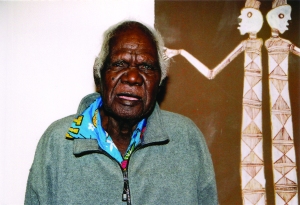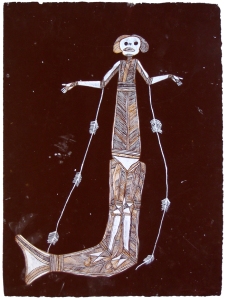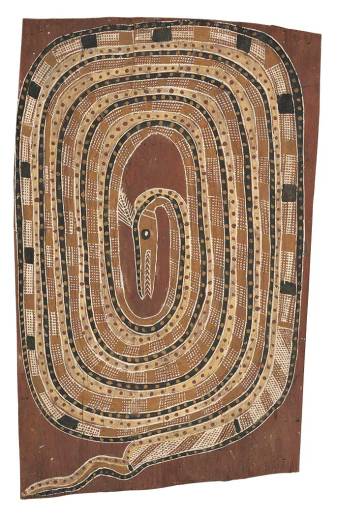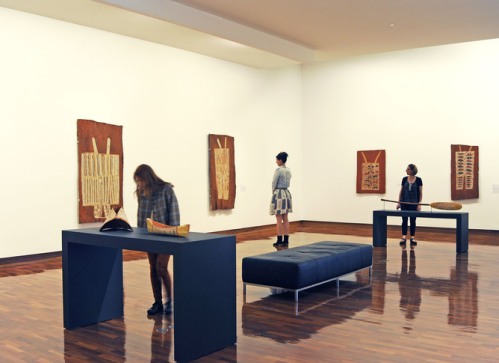The following essay was published in Art Guide Australia, November/December 2010, pp.45-49

It is a strange feeling to be waiting for a giant. That is how I found myself, on a particularly hot afternoon in February 2006, as I watched passengers disembark from an aeroplane into the terminal at Tullamarine Airport. I had never met Bardayal Nadjamerrek, but I knew his artworks intimately. From the moment I first saw them, I was transfixed by their gravity and seriousness. Though I could not yet interpret what they were saying, I could recognise the terse eloquence and profound conviction with which they spoke. It was the paintings of Bardayal Nadjamerrek that awakened me to the beauty and relevance of Indigenous culture, and helped shape my appreciation and understanding of Aboriginal art. Such a personal tribute might seem small recognition for an artist of his standing, but it is a fitting salute to an artist and leader who spent much of his life striving to make people realise the value of Indigenous knowledge. Over the past four decades, he was a towering figure in Indigenous art and culture, more than living up to the epithet ‘Lofty’ that was foisted upon him as a young man working on the tin mines at Maranboy. Platitudes are hardly necessary; his legacy is assured.
As the stream of passengers slowed to a trickle, at last an old man was wheeled from the aeroplane. Sensing us approach, he pushed himself up from the chair, unfolding to his towering height. Waving his long spindly arms upwards, he gestured towards us, and in a rich husky voice, declared, “I’m Bardayal Nadjamerrek.”
Bardayal was born around 1926 at Kukkulumurr in the upper reaches of the Mann River region of Western Arnhem Land. His father, Yanjorluk, was from the Honey Dreaming Ankung Djang estate of the Mok Clan. His youth was spent traversing the Arnhem Land plateau with his family, developing a detailed knowledge of the stone country. During this time, he began his long artistic apprenticeship, watching his father and other men paint on the rocky outcrops and shelters. With the onset of World War II, Bardayal was indentured to service cutting timber for the war effort. Later in life, he worked as a miner, stockman, buffalo shooter and market gardener. Despite this, his connection to traditional culture remained strong, and he remained active in the ceremonial activities of the region.
In his later years, Bardayal would come to be respected as one of the most senior and important leaders in Western Arnhem Land. From the 1970s, he was instrumental in assisting Indigenous families to return to their traditional lands, helping to establish six different outstations. It was only in the mid-1990s that he was able to achieve his goal of returning to his own clan estate, by which stage government funding for outstations had ceased. Not to be deterred, Bardayal funded the creation of an outstation at Kubulwarnamyo himself. This tiny, makeshift community became like a bush university – a magnet for anthropologists, ecologists, linguists, botanists and art historians, all congregated around this grand sage of the Arnhem Land plateau. Bardayal was a true renaissance man, an encyclopaedia of knowledge on every subject of the stone country. Countless research projects and community programs poured from his tiny outstation, promoting Indigenous land management, heritage and culture.
In some ways, the magnitude of Bardayal’s cultural, social and environmental accomplishments has obscured his artistic achievements. In part due to the market fetish for ‘abstract’ Indigenous art, Bardayal’s work has often been consigned to the unfashionable margins of ‘ethnographic’ art. Even his strongest supporters have tended to focus on his close connection to the rock art heritage of Western Arnhem Land. But Bardayal Nadjamerrek was also a pioneering contemporary artist of the highest order.
Bardayal began painting professionally in 1969 at the Church Mission Society’s Oenpelli mission, under the encouragement of linguist Peter Carroll. Although aged in his mid-forties, he was already an accomplished painter, having many years experience in the rock-art galleries of the stone country. In this sense, Bardayal belonged to an ancient tradition, but it was far from a static tradition. On the rock faces, Bardayal was exposed to a palimpsest of styles, from recent images painted by his father and relatives through to much more ancient images attributed by the Kunwinjku people to ancestral mimih spirits. Bardayal’s paintings were not simply facsimiles of older works originally painted in rock shelters; his was a singular and extraordinary talent. Immediately recognisable, his work stands out from that of his peers in both its individuality and quality.
Bardayal Nadjamerrek was thus a renaissance man of Western Arnhem Land, at a time when the region as a whole was experiencing huge cultural transformation. In thinking about the idea of renaissance, it is worth comparing Bardayal’s achievements to an artist who might be thought of as his Italian counterpart: Giotto di Bondone. Like Bardayal Nadjamerrek, Giotto’s work was steeped in tradition – in his case, the extraordinary aesthetic accomplishments of the Byzantine Empire. Yet, through their individuality, both artists helped spark an artistic revolution. Like Giotto, Bardayal Nadjamerrek should be seen as a pioneering artist who paved the way for the radical developments that would follow him. Kenneth Clarke once said of Giotto, “Once we have learnt Giotto’s language, we can recognise him as one of the greatest masters of painted drama that has ever lived.” The same could be said for Bardayal Nadjamerrek.

Although his experience as a painter of rock art made him a proficient draughtsman, there are profound difference between rock art and art painted on bark, paper or canvas. Bardayal’s career shows him tackling this with increased sophistication. By the late 1980s, he had settled into a mature style both unmistakably unique and perfectly attuned to the dramatic possibilities of the canvas. He refined the visual language learnt from the rock art heritage, but over his career, Bardayal Nadjamerrek can be seen to experiment with iconographic elements for maximum artistic and allegorical effect. Take, for instance, one of his best-known images, Ngalyod – The Rainbow Serpent, a large mural of which hangs in the arrivals hall of the Darwin International Airport. Bardayal depicts Ngalyod as a combination of animals – the body of a snake, the head of a crocodile and the tail of a fish, with water lilies growing from its back. The importance of this amalgam is threefold. On the one hand, it pays reference to Ngalyod’s status as the ‘mother of all species’, but in another sense, it is about balancing the iconic with the transformative. In the Dreamtime, Ngalyod was said to assume a range of different forms, morphing from one into another.
The severity and gravity of Bardayal’s works mean that they are not as dynamic as some of his contemporaries or followers. In this sense, he is also like Giotto – in both artists, the weight of the figures gives them a heavy sense of static solemnity, so that Bardayal’s paintings can be seen almost like the icons of the Byzantine era. However, by picturing his images, such as Ngalyod, with a transformative potential (having all options included in the image at once), Bardayal’s works become less like frozen snapshots, and become something much more ethereal, as in his depictions of Yawk Yawk – the female water spirit. Just as in the Western myth of Mermaids, Yawk Yawk are believed to have legs while on land, and a fish’s tail when in the water. In Bardayal’s painting, however, the Yawk Yawk is shown having legs within her tail – or rather, having both legs and tail simultaneously. In doing so, Bardayal suggests the presence of multiple possibilities, while creating the dynamic tension of evoking the fleeting moment of transformation.

This visual inventiveness characterises Bardayal’s best works. He was a master of narrative painting, and his images have a searing, haunting intensity. Bardayal’s works gain potency from his sophisticated sense of form and ability to devise complex visual allegories. In the generation that followed Bardayal’s, many Kunwinku artists found a new allure by the introduction of shimmering cross-hatching. It was a path Bardayal refused to go down, claiming it was culturally inappropriate for him. He preferred to stick to the old-style single-line rarrk, like the old people did on the rock shelters. This distinguished him as one of a small group of elderly artists, that included his dear friend Dick Nguleingulei Murrumurru, Peter Nabarlambarl, Bob Namundja, and Kalarriya ‘Jimmy’ Namarnyilk. Of this pioneering school of artists, only the last-named survives.
The last time I saw Bardayal Nadjamerrek was in October 2008. He had retired from painting, but his final works were hanging in the exhibition Continuity: Culture, Country and Family at Mossenson Galleries in Melbourne, alongside those of his son Freddie Nadjamerrek, son-in-law Gabriel Maralngurra, and grandchildren Gavin Namarnyilk, Maath Maralngurra, Allan Nadjamerrek, Ray Nadjamerrek, and Simone Nadjamerrek. The old man had not been expected to travel to Melbourne for the exhibition, but, against the instructions of his daughters, he had flown the coop to be with his grandsons at their exhibition. It was a powerful gesture, palpable at the opening, drawing tears from the normally stoic gallery director Diane Mossenson. On the night, Bardayal spoke of his own mortality:
I’m an old man now. Me no good. I might die soon. I don’t know yet. But I’ve lived good at Kabulwarnamyo – with lots of good balanda [whitefellas] and bininj [Aboriginal people]. But no one was doing proper bininj paintings … and that’s what they’re doing now – painting all my bim [paintings], all my stories, my grandchildren painting my way now.
In November 2009, I travelled to Gunbalanya for the state funeral of Bardayal Nadjamerrek. It was late in the build-up, and the air hung heavily, as though in sympathy to the sense of irreplaceable loss that hovered in the crowded Uniting church. After the funeral, over tea and biscuits at Injalak Arts and Craft, the art centre’s director Anthony Murphy pulled out a body of paintings by Bardayal’s grandchildren, destined for a forthcoming exhibition in Melbourne. In the year since his visit, the young men had grown in confidence and assurance. They had kept the single line of their grandfather, but slowly their individual identities were becoming apparent beneath his lofty shadow. In that moment, I was transported back to Melbourne in 2007. Sitting before one of his paintings – a beautiful, delicate figure on a red ground – Bardayal had sung the song of Karrarrkbarl – The Moonman. It was not one of Bardayal’s stories, but one that had been entrusted to him by a dying friend. At the end of each month, as the moon wains, Karrarrkbarl sings a mournful song because the moon is dying. At the beginning of the new cycle, as the moon reappears, he begins to sing a happy song to bring the moon back to life. But if Karrarrkbarl does not sing, the moon will not return. In the tentative paintings of Bardayal’s grandchildren, I heard the murmur of a familiar old tune. On bark, paper and canvas, Bardayal Nadjamerrek left an indelible song whose echoes will continue to brighten the cultural landscape for many years to come.










